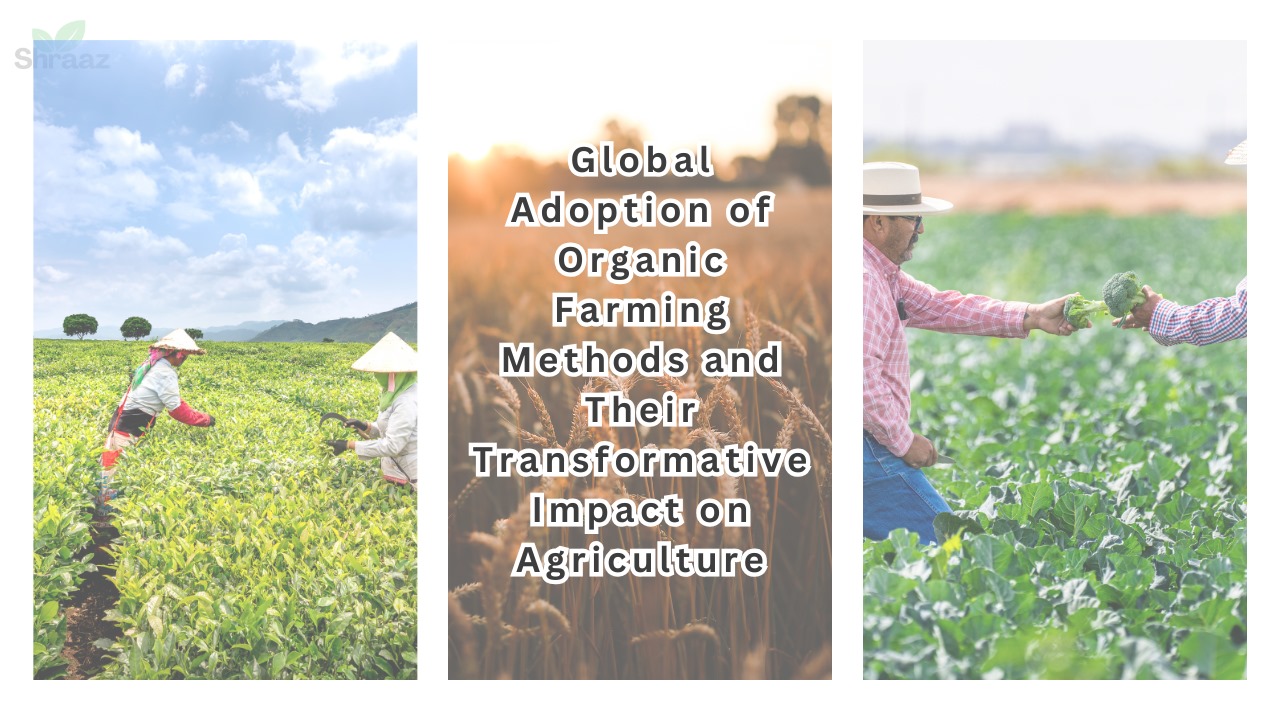Introduction to Global Adoption and Impact of Organic Farming on Agriculture
Organic farming has emerged as a critical component of the global agricultural landscape, promoting sustainable practices that prioritize environmental health, animal welfare, and human nutrition. As consumer awareness around health and sustainability grows, the demand for organic products has surged, prompting farmers and agricultural stakeholders to reconsider their methods. In this article, we explore the global adoption of organic farming methods, examining their transformative impacts on agriculture, the factors driving their adoption, and the barriers that still need to be addressed.
The organic farming sector has seen remarkable growth in recent years. According to the Research Institute of Organic Agriculture (FiBL), the global market for organic food reached approximately $120 billion in 2020, up from $50 billion in 2010. This rapid growth underscores the increasing importance of organic farming in ensuring food security, promoting environmental sustainability, and fostering healthier communities.
For a broader discussion of overall organic farming beyond just Global Adoption and the Impact of Organic Farming, check out The Comprehensive Guide to Organic Farming: Principles, Practices, and Future Prospects.
The Growing Global Demand for Organic Products
The demand for organic products has skyrocketed in recent years, driven by a combination of health, environmental, and ethical concerns. This section delves into the market growth, consumer preferences, and future projections of organic food.
Market Growth of Organic Foods
The organic food market has experienced exponential growth, reflecting changing consumer preferences. In 2020, the organic food market was valued at $120 billion and is projected to continue growing at a compound annual growth rate (CAGR) of 10.5% from 2021 to 2028 . Key factors contributing to this growth include:
- Increased Health Awareness: More consumers are becoming aware of the health risks associated with pesticides and GMOs (genetically modified organisms). A survey conducted by the Organic Trade Association (OTA) found that 77% of consumers reported choosing organic products to avoid pesticides .
- Environmental Consciousness: Organic farming practices are seen as more sustainable, appealing to environmentally conscious consumers. According to the World Bank, organic farming helps preserve biodiversity, improve soil health, and reduce greenhouse gas emissions .
Consumer Awareness
Consumer awareness around the benefits of organic products is at an all-time high. Social media, documentaries, and increased media coverage of food-related issues have all contributed to this awareness. Notably:
- Social Media Influence: Platforms like Instagram and Facebook have popularized organic lifestyles, leading consumers to prioritize organic foods in their shopping decisions.
- Educational Campaigns: Various organizations are running campaigns to educate consumers about the benefits of organic farming, further driving demand.
Shifts in Consumer Preferences
Consumer preferences have shifted towards organic products across various demographics. Notable trends include:
- Younger Consumers: Millennials and Gen Z are leading the charge in organic product consumption, with a 2019 study indicating that 55% of younger consumers prefer organic foods .
- Plant-Based Diets: The rise of plant-based diets has also contributed to the demand for organic fruits and vegetables.
Market Projections
The future of the organic food market looks promising, with projections indicating continued growth. According to a report by Grand View Research, the global organic food market is expected to reach $510 billion by 2028 . Factors that will likely drive this growth include:
- Increased Availability: As more farmers adopt organic methods, the availability of organic products will increase.
- Government Support: Policies promoting sustainable farming practices are expected to boost organic farming further.
Factors Driving the Adoption of Organic Farming Worldwide
Several key factors are driving the global adoption of organic farming methods. Understanding these factors can help stakeholders identify opportunities and challenges in the organic farming sector.
Health and Food Safety Concerns
Health concerns associated with conventional farming practices have led consumers to seek out organic alternatives. Research has shown that:
- Pesticide Residues: A study by the European Food Safety Authority (EFSA) found that over 50% of conventional fruits and vegetables contained pesticide residues . In contrast, organic products are grown without synthetic pesticides, appealing to health-conscious consumers.
Environmental Benefits
Organic farming practices contribute to environmental sustainability in multiple ways:
- Soil Health: Organic farming enhances soil fertility through crop rotation, composting, and reduced chemical use .
- Biodiversity: By avoiding synthetic inputs, organic farms promote biodiversity, benefiting both wildlife and crop production.
Climate Change and Resilience
Organic farming can help mitigate climate change impacts:
- Carbon Sequestration: Organic practices such as cover cropping and reduced tillage improve soil carbon sequestration, thus reducing greenhouse gases in the atmosphere .
- Resilience to Extreme Weather: Organic systems tend to be more resilient to extreme weather events, providing farmers with better adaptive capacity.
Economic Drivers
Economic factors play a crucial role in the adoption of organic farming methods:
- Premium Pricing: Organic products often command higher prices, providing farmers with greater profit margins .
- Cost Reduction: Farmers can reduce input costs by avoiding synthetic fertilizers and pesticides, leading to long-term financial sustainability.
Policy and Government Support
Government policies significantly impact the adoption of organic farming:
- Subsidies and Incentives: Many governments offer subsidies for organic farmers, making the transition financially viable.
- Regulatory Frameworks: Robust certification processes and regulations help build consumer trust in organic products.
Regional Adoption of Organic Farming: Key Insights
The adoption of organic farming methods varies significantly across different regions. This section provides an in-depth look at key regions and their unique challenges and opportunities.
North America
United States
The United States is a leader in organic farming, with over 3 million acres of farmland certified organic as of 2020. Key points include:
- Market Size: The U.S. organic market was valued at approximately $62 billion in 2020, with a strong demand for organic fruits and vegetables .
- Challenges: Despite the growth, challenges include high transition costs and the complexity of the certification process.
Canada
Canada has also seen significant growth in organic farming:
- Market Growth: The organic market in Canada reached approximately $4.4 billion in 2020.
- Government Support: Canadian government programs promote organic farming through various initiatives.
Europe
European Union
The EU has implemented strict organic farming regulations:
- Market Size: The organic market in Europe was valued at around $50 billion in 2020.
- Sustainability Initiatives: EU policies focus on sustainability and support organic farming through funding and education.
Leading Countries
Countries like Germany, France, and Italy are at the forefront of organic farming:
- Germany: The largest organic market in Europe, valued at $15 billion in 2020.
- Italy: Known for its organic wine production and olive oil, contributing significantly to its organic sector.
Latin America
Brazil
Brazil is a major player in organic farming in Latin America:
- Market Size: The Brazilian organic market reached $1.2 billion in 2020, driven by exports.
- Challenges: Issues like land tenure and access to markets hinder further growth.
Argentina and Mexico
- Argentina: Significant organic production, especially in soybeans and fruits.
- Mexico: Growth in organic coffee and vegetables, with government support helping small-scale farmers.
Asia
China
China has rapidly expanded its organic farming sector:
- Market Growth: The organic market in China is projected to reach $14 billion by 2025 .
- Government Initiatives: Policies encouraging organic farming are helping farmers transition.
India
India is seeing a rise in organic farming, particularly among smallholder farmers:
- Market Size: The Indian organic market reached $1.5 billion in 2020 .
- Government Support: Initiatives like the Paramparagat Krishi Vikas Yojana (PKVY) promote organic farming practices.
Africa
South Africa
South Africa is leading organic farming efforts in Africa:
- Market Size: The organic market is valued at $350 million.
- Wine Industry: The country is known for its organic wine production.
Sub-Saharan Africa
- Smallholder Farmers: Organic farming offers sustainable solutions for smallholders.
- Challenges: Issues like market access and infrastructure remain obstacles.
Australia and Oceania
Australia’s Role
Australia is recognized for its organic farming practices:
- Market Size: The Australian organic market was valued at approximately $2.6 billion.
- Export Opportunities: The country exports organic products, including wine and fruits.
New Zealand
- Organic Sector Growth: New Zealand has seen growth in organic dairy and wine.
- Challenges: Adapting to climate change impacts poses a challenge for farmers.
Transformative Impacts of Organic Farming on Agriculture
The adoption of organic farming methods has led to numerous transformative impacts on agriculture. This section highlights the key effects on the environment, economy, and society.
Environmental Transformation
Organic farming promotes sustainable practices that have a positive impact on the environment:
- Biodiversity: Organic farms are typically more biodiverse, providing habitats for wildlife and contributing to ecosystem health.
- Soil Health: Practices such as crop rotation and cover cropping enhance soil fertility and structure.
Social and Economic Changes
The rise of organic farming has brought about significant social and economic changes:
- Job Creation: Organic farming often requires more labor, creating job opportunities in rural areas.
- Community Engagement: Organic farmers often engage with their communities, leading to increased local food production.
Health and Well-being
Organic farming contributes to improved health outcomes:
- Nutritional Benefits: Organic foods are often richer in nutrients and free from harmful chemicals.
- Reduced Pesticide Exposure: Consumers benefit from reduced exposure to harmful pesticides associated with conventional farming.
Technology and Innovation in Organic Farming
The organic farming sector is embracing technology and innovation:
- Precision Agriculture: The use of data and technology helps optimize organic farming practices.
- Sustainable Practices: Innovations in sustainable agriculture are transforming organic farming methods.
Policy and Institutional Impact
Government policies and institutions play a crucial role in the organic farming landscape:
- Funding and Support: Many governments offer financial incentives to support organic farmers.
- Research and Development: Ongoing research helps improve organic farming practices and technologies.
Barriers to Global Adoption of Organic Farming
Despite the growing interest in organic farming, several barriers impede its widespread adoption. Understanding these challenges is crucial for fostering growth in the sector.
High Transition Costs
Transitioning from conventional to organic farming can be costly:
- Financial Burden: Farmers often face significant upfront costs associated with transitioning, including certification fees and investment in new practices.
Certification and Standards Challenges
The certification process can be complex and time-consuming:
- Regulatory Hurdles: Different regions have varying certification standards, which can confuse farmers.
- Cost of Certification: The cost associated with obtaining and maintaining organic certification can be prohibitive for many smallholders.
Labor and Knowledge Gaps
A lack of trained personnel can hinder organic farming adoption:
- Education and Training: Farmers may lack access to education and training on organic practices, affecting their ability to transition successfully.
Market Access and Infrastructure
Limited access to markets poses a significant challenge:
- Supply Chains: Insufficient infrastructure for organic products can restrict market access for farmers.
- Consumer Awareness: In some regions, consumers may not be aware of organic products, limiting demand.
Resistance to Conventional Farming
The influence of conventional farming practices can hinder the growth of organic farming:
- Chemical Industry Lobbies: The chemical industry often resists changes that would promote organic farming practices
.
The Future of Organic Farming: Opportunities and Innovations
Looking ahead, the future of organic farming is promising, with numerous opportunities and innovations on the horizon. This section explores the potential for growth in the organic farming sector.
Integration of Advanced Technologies
The adoption of advanced technologies can enhance organic farming practices:
- Data-Driven Decision-Making: Tools like drones and precision agriculture can help optimize organic farming operations.
Corporate Involvement and Investment
The involvement of corporations in organic farming is on the rise:
- Investment Opportunities: Corporations are increasingly investing in organic farming, recognizing the growth potential in this sector.
Potential for Growth in Emerging Markets
Emerging markets present significant opportunities for organic farming:
- Untapped Potential: Regions like Southeast Asia and Sub-Saharan Africa offer considerable opportunities for organic farming growth.
Public and Private Partnerships
Collaborative efforts can bolster organic farming initiatives:
- Joint Programs: Partnerships between governments, NGOs, and private entities can support organic farming through education and funding.
Sustainable Agriculture Models
Organic farming aligns with broader sustainable agriculture initiatives:
- Agroecology and Permaculture: These models promote sustainable farming practices that enhance food security and environmental health.
Conclusion
The global adoption of organic farming methods represents a transformative shift in the agricultural landscape. As consumer demand for organic products continues to rise, the benefits of organic farming—ranging from improved health outcomes to environmental sustainability—are becoming increasingly evident. While challenges remain, the future of organic farming looks promising, with opportunities for growth and innovation that can reshape the way we produce and consume food. By addressing the barriers to adoption and fostering supportive policies, we can pave the way for a more sustainable agricultural future.




